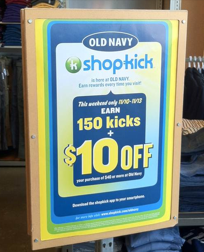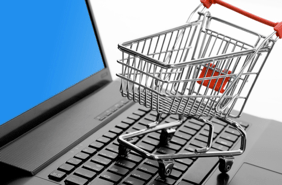Online holiday shopping reached record levels in 2010. And e-commerce spending is up this year. All signs point to consumers spending even more online this holiday season. I sat down with executives from Google, eBay, PayPal and ShopKick to discuss the trends that are expected to emerge in the e-commerce space over the next few months. They center around mobile, tablets, and deals.
PayPal has more than doubled its mobile payments volume since the 2010 holiday shopping season, and we haven’t even hit the thick of this year’s rush. eBay is projecting $5 billion in mobile payments volume in 2010 and this number could increase in the next few months. And Google projects that 15 percent of total search on Black Friday (the day after Thanksgiving and one of the biggest shopping days of the year) will come from mobile devices. Tablet devices are now a part of the online shopping experience and retailers are taking note. Clearly, all signs point to the fact that this could be the breakout year for mobile shopping.
Mobile, Mobile, Mobile
All of the companies I spoke to unanimously agreed that this would be the year of mobile for the holiday shopping season. Steve Yankovich, head of eBay’s mobile business operations and development, says he expects this to be the biggest year for mobile sales for eBay yet. eBay has said that the company expects to see $5 billion in gross merchandise volume in 2011, and this will be partly buoyed by a strong mobile presence in November and December.
PayPal’s Senior Director for Mobile, Laura Chambers, echoes Yankovich’s forecasts and says that merchants are even preparing for the onslaught of traffic to their mobile sites. A number of big retailers, such as Armani Exchange, Guess and The Limited have recently put PayPal’s mobile express checkout as an option for payments on their mobile sites as a way to help the conversion process. “We are seeing strong investments by online retailers for mobile shopping this year,” she says.
Chambers says that last year, the peak day for mobile payments for PayPal was December 12, with $4.7 million in mobile payments volume. Now PayPal is seeing $10 million in mobile payments per day, and we haven’t even officially hit the holiday shopping period. Clearly, the mobile payments numbers could even triple from last year to this year.
While many consumers may shop on mobile for their holiday purchases, the usage of product search, barcode scanning, and other informative apps will also play a big part in this year’s mobile shopping. eBay’s RedLaser barcode scanning apps have seen scans go up 50 percent over the past year. If you aren’t familiar with how it works, RedLaser will scan the barcode of a physical product and show you where you can buy it on eBay’s properties and where it is available in local store locations around you (via Milo) and for how much. The app has been updated with PayPal functionality so that users can actually buy the product directly from the app.
Another shopping app developer who has high hopes for mobile this holiday season is ShopKick. Co-founder Cyriac Roeding says that this year will be the year of mobile for physical shopping. For background, Shopkick automatically recognizes when someone with the free Android or iPhone app on their phone walks into a store. Once a Shopkick Signal is detected, the app delivers reward points called “kickbucks” to the user for walking into a retail store, trying on clothes, scanning a barcode and other actions. Kickbucks can then be redeemed across all partner stores for gift card rewards or for Facebook Credits. User can also receive special discounts on specific products at partners stores like Macy’s, Best Buy or Target.
 Roeding explains that the cell phone is the only interactive platform you carry with you in a physical store, and retailers are looking to use the platform to help drive transactions. Clearly, a mobile rewards app that offers in-store discounts can help do this. “The internet has caused brick and mortar retailers more trouble than benefit over the past fifteen years. Now retailers are catching on to how the internet can help retailers—that’s where mobile comes in.”
Roeding explains that the cell phone is the only interactive platform you carry with you in a physical store, and retailers are looking to use the platform to help drive transactions. Clearly, a mobile rewards app that offers in-store discounts can help do this. “The internet has caused brick and mortar retailers more trouble than benefit over the past fifteen years. Now retailers are catching on to how the internet can help retailers—that’s where mobile comes in.”
Sameer Samat, VP of Product Management for Google Commerce, tells me that the search giant is seeing a growing number of users are making buying decisions using their mobile phone. “We are definitely seeing m-commerce conversions growing and becoming bigger over time,” he says. “But users are also using their mobile phone to search for products and find local availability.”
Samat says that Google has seen a 200 percent growth in mobile product search usage and Google Shopper app downloads over the past year. Shopper, which is available for iOS and Android, allows you to find product prices, reviews, specs, local inventory of products at nearby stores, and more.
As we mentioned above, Google is forecasting that 15 percent of total search on Black Friday. will come from mobile. “There’s no doubt that users are now making buying decisions using their mobile phone,” says Samat. “And we are seeing m-commerce conversions growing and becoming bigger over time.”
Tablets
As tablets have grown to be the go-to browsing device, the iPad, and other devices are also becoming a way to shop. And retailers are catching on to this trend. According to a National Retail Federation study, 20 percent of retailers have invested in tablet device apps this holiday season.
 With this in mind, Google debuted Catalogs in August, an app for tablet devices that includes 200 catalogs from major brands including Anthropologie, Bare Escentuals, Bergdorf Goodman, Crate and Barrel, L.L. Bean, Lands’ End, Macy’s, Neiman Marcus, Nordstrom, Pottery Barn, Saks Fifth Avenue, Sephora, Sundance, Tea Collection, Urban Outfitters and Williams-Sonoma.
With this in mind, Google debuted Catalogs in August, an app for tablet devices that includes 200 catalogs from major brands including Anthropologie, Bare Escentuals, Bergdorf Goodman, Crate and Barrel, L.L. Bean, Lands’ End, Macy’s, Neiman Marcus, Nordstrom, Pottery Barn, Saks Fifth Avenue, Sephora, Sundance, Tea Collection, Urban Outfitters and Williams-Sonoma.
The app is more than just a browsing experience. When consumers find an item they’d like to purchase, they can tap to find it in a store nearby or tap “Buy on Website” to visit the merchant online.
Google’s Samat says that “the tablet is the ultimate leanback experience and we see that playing a big role in holiday shopping as a replacement for the mail order catalogs you used to browse through.”
PayPal calls it ‘couch commerce’ and believes that tablet commerce will have a record year. PayPal recently reported that consumers who own both a tablet and a smartphone are significantly more likely (63%) to indicate increased overall spending on mobile purchases, versus owners of smartphones only (29%). Owners of both a tablet and a smartphone buy nearly twice as often as those who only have smartphones and more than 40% of dual owners made more than 20 mobile purchases over the past year, compared to only 12% of smartphone-only owners.
Forrester just released a report predicting a 15 percent increase in online shopping sales this year to nearly $60 billion, partly due to the increase in consumer-use of tablet computers for shopping.
Beyond Black Friday And Cyber Monday
Black Friday and Cyber Monday are historically the top-high-grossing online shopping days during the holiday season. But execs expect to see high volumes of online shopping on other days thanks to an increase in mobile shopping and deals.
Yankovitch tells me that eBay expects revenue numbers to be well over numbers that eBay saw last year for Black Friday and Cyber Monday, but expects to see more activity at times when people aren’t traditionally shopping.
The day of Thanksgiving is one of those days, says Chambers. Because people will have their phone everywhere (including at the table), consumers are expected to make purchases on the fly, especially on Thanksgiving evening. In fact, PayPal is predicting that after dinner on Thanksgiving Day will be the first mobile shopping spike this holiday season.
Another popular day has been the second Sunday in December, which is one of the last days where people feel confident that items will be shipped in times for the holiday. And Chambers says across the board, Sunday is the biggest day for mobile shopping generally.
Deals
There’s no doubt that deals, coupons and discounts will be a large part of the online holiday shopping experience, especially with the current state of the economy. According to the recent Forrester report, 58 percent of Americans say they are more price-conscious today than they were a year ago and nearly half believe they find better values online.
“I really expect consumers to be deal hunting this season,” explains Chambers. She says that PayPal, which has historically offered special deals for the holiday shopping season, will be bulking up on more consumer deals this holiday season.
Samat says that Google has always seen a spike for queries like deals, coupons, and sales during the holiday time and fully expects to see an increase this year. “The consumer desire for a better deal will help give certain product decision tools a big bump,” he explains. “People may take more time this year to find the best possible price.”
Deals could also include lucrative holiday shipping offers. In 2010, 45 of the top 50 online retailers offered some sort of promotional deal between Thanksgiving and Cyber Monday, most of which were a type of shipping promotion. And in 2011, Shop.org anticipates that a record 92.5% of online retailers will offer free shipping and not just as a Cyber Monday promotion.
Clearly, there’s plenty of optimism from retailers, and tech companies regarding online spending and shopping this holiday season. And this holiday season is somewhat unique considering the big bet that retailers are making on newer technologies, such as mobile, geo-location, tablets, local product search and more. The big question is how consumers will react to and engage with these technologies over the next several weeks. It could be a very mobile Christmas.
